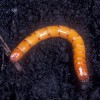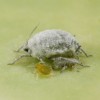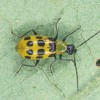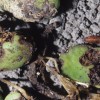 Insects in the family Elateridae are commonly known as click beetles. Their name comes from the clicking sound they make while attempting to right themselves after falling or being placed on their backs. The larvae of click beetles are called wireworms. The corn wireworm is a serious agricultural pest and was added to the EPPO A1 action list of quarantine pests in 2002. This 6-page fact sheet was written by Harsimran K. Gill, Gurminder Chahil, Gaurav Goyal, Jennifer L. Gillett-Kaufman and Ronald Cherry, and published by the UF Department of Entomology and Nematology, January 2014.
Insects in the family Elateridae are commonly known as click beetles. Their name comes from the clicking sound they make while attempting to right themselves after falling or being placed on their backs. The larvae of click beetles are called wireworms. The corn wireworm is a serious agricultural pest and was added to the EPPO A1 action list of quarantine pests in 2002. This 6-page fact sheet was written by Harsimran K. Gill, Gurminder Chahil, Gaurav Goyal, Jennifer L. Gillett-Kaufman and Ronald Cherry, and published by the UF Department of Entomology and Nematology, January 2014.
http://edis.ifas.ufl.edu/in1025
Tag: Harsimran K. Gill
Cabbage aphid Brevicoryne brassicae Linnaeus (Insecta: Hemiptera: Aphididae)
 Cabbage aphids cause significant yield losses to many crops of the family Brassicaceae, which includes the mustards and crucifers. It is important to have a comprehensive understanding of this pest and its associated control measures so that its spread and damage can be prevented. This 5-page fact sheet was written by Harsimran Kaur Gill, Harsh Garg, and Jennifer L. Gillett-Kaufman, and published by the UF Department of Entomology and Nematology, October 2013.
Cabbage aphids cause significant yield losses to many crops of the family Brassicaceae, which includes the mustards and crucifers. It is important to have a comprehensive understanding of this pest and its associated control measures so that its spread and damage can be prevented. This 5-page fact sheet was written by Harsimran Kaur Gill, Harsh Garg, and Jennifer L. Gillett-Kaufman, and published by the UF Department of Entomology and Nematology, October 2013.
http://edis.ifas.ufl.edu/in1014
Spotted cucumber beetle Diabrotica undecimpunctata howardi Barber (Insecta: Coleoptera: Chrysomelidae)
 Spotted cucumber beetle is a major agricultural pest of North America. Another name for the spotted cucumber beetle is “southern corn rootworm”. Many Diabrotica species cause damage to field crops, especially corn, making these beetles a major agricultural concern. Because of the subterranean nature of their larvae, these insects are hard and expensive to control. This 6-page fact sheet was written by Harsimran Kaur Gill, Gaurav Goyal, and Jennifer Gillett-Kaufman, and published by the UF Department of Entomology and Nematology, September 2013.
Spotted cucumber beetle is a major agricultural pest of North America. Another name for the spotted cucumber beetle is “southern corn rootworm”. Many Diabrotica species cause damage to field crops, especially corn, making these beetles a major agricultural concern. Because of the subterranean nature of their larvae, these insects are hard and expensive to control. This 6-page fact sheet was written by Harsimran Kaur Gill, Gaurav Goyal, and Jennifer Gillett-Kaufman, and published by the UF Department of Entomology and Nematology, September 2013.
http://edis.ifas.ufl.edu/in1008
Seedcorn maggot, Delia platura (Meigen) (Insecta: Diptera: Anthomyiidae)
 The seedcorn maggot is a polyphagous pest, affecting more than 40 different host plants. It is an important pest of germinating soybeans and corn, and also attacks a wide range of horticultural crops including beans, peas, cucumber, melon, onion, pepper, potato, and other vegetables. Seedcorn maggots damage newly planted seeds by feeding on seed contents, often leaving empty seed shells and preventing germination. Although usually no more than 2% of the seedlings get infested by this insect, 30% to 60% plant loss may occur in the field. This 5-page fact sheet was written by Harsimran Kaur Gill, Gaurav Goyal, and Jennifer L. Gillett-Kaufman, and published by the UF Department of Entomology and Nematology, July 2013.
The seedcorn maggot is a polyphagous pest, affecting more than 40 different host plants. It is an important pest of germinating soybeans and corn, and also attacks a wide range of horticultural crops including beans, peas, cucumber, melon, onion, pepper, potato, and other vegetables. Seedcorn maggots damage newly planted seeds by feeding on seed contents, often leaving empty seed shells and preventing germination. Although usually no more than 2% of the seedlings get infested by this insect, 30% to 60% plant loss may occur in the field. This 5-page fact sheet was written by Harsimran Kaur Gill, Gaurav Goyal, and Jennifer L. Gillett-Kaufman, and published by the UF Department of Entomology and Nematology, July 2013.
http://edis.ifas.ufl.edu/in1002
Citrus Mealybug Planococcus citri (Risso) (Insecta: Hemiptera: Pseudococcidae) (EENY537/IN947)
 The citrus mealybug is a common pest of citrus primarily in greenhouses, and of several ornamental plants in Florida. It has been recognized as a difficult to control pest in Europe since 1813, where it is called the greenhouse mealybug and in the United States since 1879. This 4-page fact sheet was written by Harsimran Kaur Gill, Gaurav Goyal, and Jennifer Gillett-Kaufman, and published by the UF Department of Entomology and Nematology, September 2012.
The citrus mealybug is a common pest of citrus primarily in greenhouses, and of several ornamental plants in Florida. It has been recognized as a difficult to control pest in Europe since 1813, where it is called the greenhouse mealybug and in the United States since 1879. This 4-page fact sheet was written by Harsimran Kaur Gill, Gaurav Goyal, and Jennifer Gillett-Kaufman, and published by the UF Department of Entomology and Nematology, September 2012.
http://edis.ifas.ufl.edu/in947
Common Weed Hosts of Insect-Transmitted Viruses of Florida Vegetable Crops (ENY863/IN931)
 This 12-page fact sheet expands upon and updates the information on several weeds reported as virus hosts by UF/IFAS plant pathologists in 2001 and provides links to further information on specific viruses that affect vegetable crops. Written by Gaurav Goyal, Harsimran K. Gill, and Robert McSorley, and published by the UF Department of Entomology and Nematology, April 2012.
This 12-page fact sheet expands upon and updates the information on several weeds reported as virus hosts by UF/IFAS plant pathologists in 2001 and provides links to further information on specific viruses that affect vegetable crops. Written by Gaurav Goyal, Harsimran K. Gill, and Robert McSorley, and published by the UF Department of Entomology and Nematology, April 2012.
http://edis.ifas.ufl.edu/in931
Cover Crops for Managing Root-Knot Nematodes (ENY063/IN892)

Root-knot nematodes are widespread and are pests of almost all major crops. Damage can be seen as galls or knot-like swellings produced along plant roots. Cover crops are used to manage nematodes because these microscopic roundworms can move only very short distances on their own and will starve without suitable host plants. This 6-page fact sheet describes several common cover crops that can be used for nematode management. Written by Harsimran K. Gill and Robert McSorley , and published by the UF Department of Entomology and Nematology, July 2011.
http://edis.ifas.ufl.edu/in892
The Insect Community on the Soil Surface (ENY859/IN876)
It’s easy to find and collect insects, related arthropods, and other invertebrates from the soil surface using simple materials that are readily available. This 7-page fact sheet describes several collection methods and introduces common invertebrates that are found on the soil surface in agricultural fields and gardens in Florida. It was written by Harsimran K. Gill, Robert McSorley, and Lyle Buss, and published by the UF Department of Entomology and Nematology, January 2011.
http://edis.ifas.ufl.edu/in876
ENY062/IN856 Introduction to Soil Solarization
ENY062, a 6-page illustrated fact sheet by Robert McSorley and Harsimran K. Gill, describes this practice of covering soil surface with plastic to harness the sun’s heat to manage soil weeds, nematodes, diseases and insects in soil. The authors answer frequently asked questions and outline steps for conducting soil solarization. Includes references. Published by the UF Department of Entomology and Nematology, June 2010.
http://edis.ifas.ufl.edu/in856